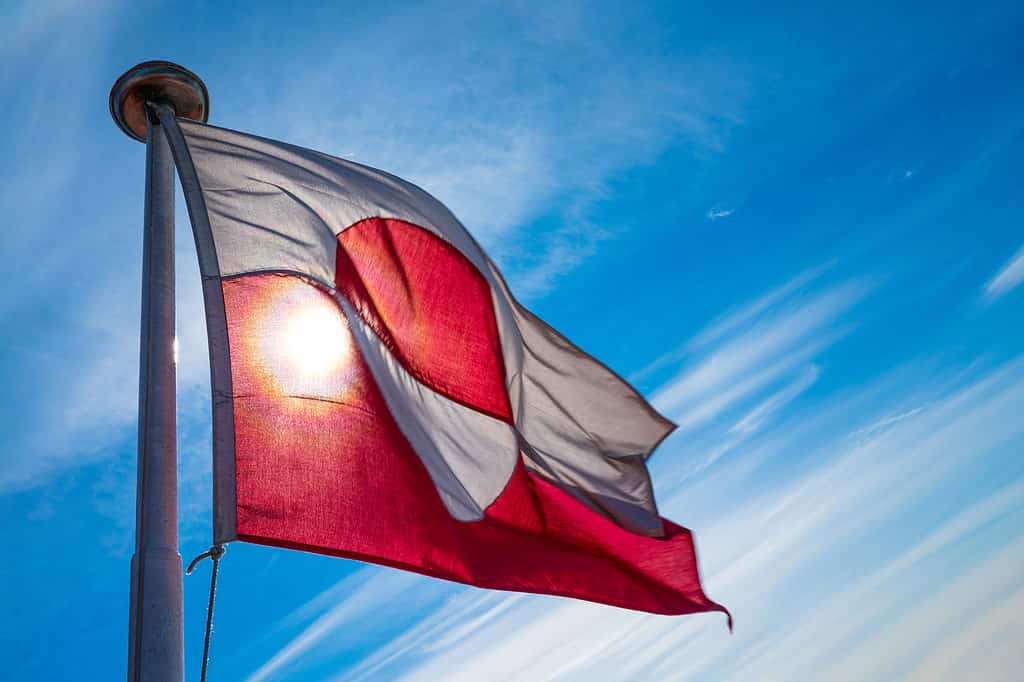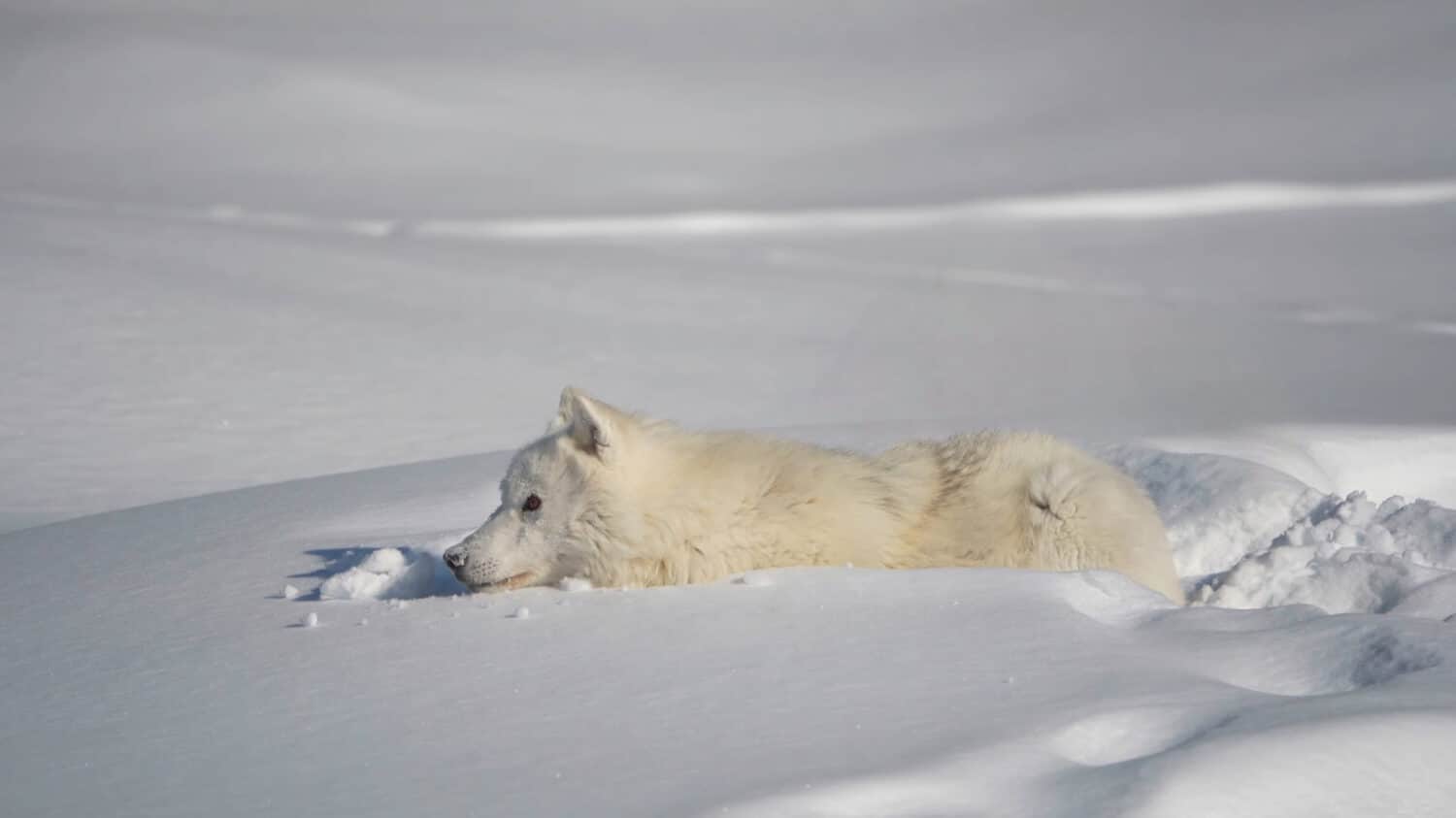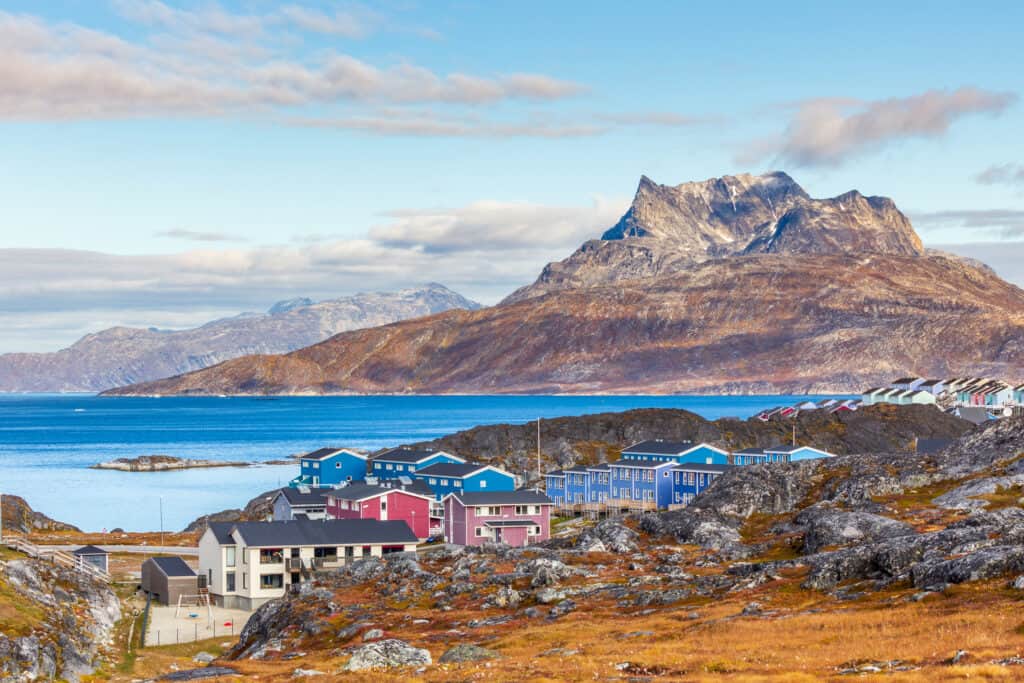What’s icy all over and the world’s largest island that isn’t a continent? You guessed it, little-known Greenland. The impressive size of Greenland places it ahead of countries like Congo and Saudi Arabia. Approximately 80% of Greenland’s surface is coated in ice, making it home to the second-largest ice sheet, after Antarctica. If melted, this ice could raise global sea levels by an alarming seven meters. Despite its vastness, Greenland’s population is sparse, making it one of the least densely populated regions globally.

The design of Greenland’s flag was the result of a competition held in 1985. The winning design was created by a Greenland native, Thue Christiansen.
©Maridav/Shutterstock.com
Understanding Greenland’s Geography
Greenland, known to its residents as Kalaalit Nunaat, forms part of the Kingdom of Denmark. Most geographers classify Greenland as part of North America due to its geological ties with the North American tectonic plate. Politically, however, Greenland is part of Europe due to its historical and administrative ties with Denmark.
Greenland’s geographical extent is both impressive and intriguing. The island covers approximately 1.45% of the Earth’s land area, equating to around 535,251,507 acres or 216,608,600 hectares. However, merely 1% of this massive area is suitable for farming due to the prevalent ice cover. Most of Greenland’s settlements are strategically placed along its coast. The island’s interior is almost entirely covered by a thick ice sheet. This ice cover’s presence translates to about 836,330 square miles or 2,166,086 square kilometers of land, mainly inaccessible and uninhabitable.
Greenland is the largest landmass closest to the North Pole. The island’s northernmost point, Cape Morris Jesup, is only 460 miles away.
Greenland’s Size in Perspective
Due to the Mercator misconception, a commonly used cylindrical map projection, Greenland appears exaggerated on most world maps. Mercator projections distort the size of landmasses around the poles. As a result, Greenland appears larger than continents like Africa and landmasses such as South America on Mercator-projected maps.
Comparisons That Help Us Better Understand Greenland’s Size
- Greenland is about three times smaller than the United States. However, due to the Mercator projection commonly used in world maps, it often appears larger than its actual size.
- Australia, the smallest continent, is about three and a half times larger than Greenland.
- Greenland’s area is about 2.16 million square kilometers, making it slightly smaller than the entire continent of Europe.
- Africa, the second-largest continent, is approximately 14 times larger than Greenland.
- If it was possible to flatten out all the crevices and mountains in Greenland’s ice sheet, it would cover an area about the size of the entire African continent!
- Despite its large size, Greenland has an exceedingly small population. With a population of just 56,653, it is less populated than many small cities in the world.
- Greenland has a coastline that’s approximately 27, 394 miles long. This is greater than the Earth’s circumference at the Equator (24,901 miles). This highlights the irregular, fjord-riddled nature of Greenland’s geography, which significantly extends its effective coastline.
Fun Ways to Compare Greenland’s Size
- If you were to stack the Eiffel Towers to match the length of Greenland, you would need over 8,000 Eiffel Towers!
- If you were to drive around the entire perimeter of Greenland at 60 miles per hour, it would take you about 14 days of non-stop driving.
- If you wanted to walk from the southernmost point of Greenland to the northernmost point, it would take you over a year to make the journey!
- You could fit the entire United Kingdom into Greenland over 12 times!
- If you were to cover the entire surface of Greenland in standard-sized Post-It notes, you would need approximately 4.4 trillion of them!
Wildlife in Greenland
Despite the extensive ice coverage, Greenland is teeming with life. It houses the world’s largest national park, the Northeast Greenland National Park. The park is a haven for a range of terrestrial and marine animals, including seals, whales, and numerous bird species. The island is home to a couple dozen or so mammal species. Only about ten of these species live on land. They include Arctic fox, Arctic hare, ermine, lemming, musk ox, reindeer, and wolf. The rest are marine mammals that live on the ice and in the sea. These include bearded seal, bow whale, hooded seal, narwhal, ringed seal, polar bear, and walrus.

Very few terrestrial mammal species call Greenland home, but the Arctic fox is one of them.
©Nikolaysad/Shutterstock.com
Government and Administration
Although Greenland is part of the Kingdom of Denmark, it has enjoyed home rule since 1979. This arrangement grants Greenlanders the same rights as Danes. It also allows them to govern their affairs in areas like taxation, economic development, education, and cultural affairs. The Inatsisartut, Greenland’s central governing body, runs on a four-year term, and its majority party elects a Prime Minister.
Population and Culture
Supersized Greenland’s population is less than 57,000, making it the least densely populated country. Nearly 90% of Greenlanders are of Inuit origin. The official languages are Kalaallisut (West Greenlandic) and Danish, with English also commonly spoken.
Agriculture in Greenland
Despite the icy landscape, Greenland has pockets of arable land that support agriculture. Global warming has resulted in more ice melting, opening additional lands for farming. This shift has enabled Greenlanders to cultivate potatoes and vegetables, and breed sheep and cattle. Such activities lend a significant boost to the local economy.

Modern Inuit people typically live in permanent houses. Yet some still hew to traditional temporary shelters when out hunting and fishing in the wilderness.
©iStock.com/Vadim_Nefedov
Greenland and the Vinland Sagas
The Vinland Sagas are 13th-century Old Norse texts illuminating early Norse exploration and settlement of Greenland and the North Atlantic. They are inclusive of the Saga of the Greenlanders and the Saga of Erik the Red. These sagas, blending historical events with folklore, offer insights into the Norse worldview and their maritime abilities.
Greenland, Climate Change, and Global Biodiversity
Greenland’s melting ice sheet, coupled with global warming, portends a severe threat to global biodiversity. A recent study investigated the repercussions of these phenomena on approximately 21,000 species across 12 biodiversity hotspots. Forecasts under a severe climate change scenario point to a considerable contraction in species’ geographical ranges. This is intensified by Greenland’s rapid ice melt. Hence, the accelerated melting of Greenland’s ice sheet could hasten the worldwide biodiversity crisis. All of which underscores the urgent need for comprehensive climate action.
Greenland’s Ice Cores
Ice cores, long cylinders extracted from Greenland’s glaciers, offer crucial insights into Earth’s climatic history and the impact of human activities. These cores serve as climatic time capsules, mapping Earth’s environmental changes and helping predict future trends.
Greenland and Tourism
West Greenland’s winter tourism industry, a major economic force in the region, is under threat from climate change. A recent study using a regional climate model reveals substantial projected increases in temperature of 33.98 to 40.28 degrees Fahrenheit by the end of this century. As a result, the length of the snow season and overall snowfall are expected to decline. This poses significant challenges for ski resorts and cross-country skiing, not to mention traditional dog sledding.
However, it’s not all bad news: ski-touring and heli-skiing seem to be more adaptable to these changing conditions. Another study that includes interviews with local stakeholders reveals concerns over these climate impacts and the need to adapt to ensure the industry’s future viability. Tourism industry decision-makers and managers will be forced to develop strategic adaptations to mitigate these negative effects and ensure the resilience of winter tourism in Greenland.
Greenland in Global Politics
Greenland is part of the Danish Realm. It’s a key player in global geopolitics owing to its strategic Arctic location and significant natural resource potential. Its political status is unique, in that it keeps a high degree of autonomy. Since the 2009 Act on Greenland Self-Government, Denmark still influences foreign policy and defense. However, Greenland is gaining increasing international relevance, a trend that may impact the prospect of its future independence.
Greenland’s importance on the world stage was illustrated in 2019 when then-U.S. President Donald Trump proposed buying the island — a clear nod to its strategic value. This value is further emphasized by the Thule Air Base, the U.S.’s northernmost military installation, found in northwest Greenland.
With abundant mineral, oil, and gas deposits, Greenland attracts global attention for potential resource extraction, particularly as climate change could make these resources more accessible. As the Arctic gains geopolitical prominence, Greenland’s role will increase, potentially reshaping Arctic geopolitics and beyond.
Conclusion
Greenland, an intriguing blend of expansive ice fields, unique wildlife, rich culture, and remote human settlements, stands as a testament to human resilience and adaptation. It’s a fascinating place that challenges conventional wisdom about what life can endure and where it can thrive. Yes, its size may seem exaggerated on our maps. But its unique characteristics, geological importance, and cultural richness make it a land of undeniable significance.
The photo featured at the top of this post is © muratart/Shutterstock.com
Thank you for reading! Have some feedback for us? Contact the AZ Animals editorial team.






